Business Process Modeling and Notation: Scenario Analysis Project
VerifiedAdded on 2022/09/16
|8
|1632
|19
Project
AI Summary
This project analyzes two business scenarios using Business Process Modeling and Notation (BPMN). The first scenario focuses on a pharmaceutical wholesaler, illustrating the order fulfillment process from salesforce interaction to delivery and invoice. Swim lanes are used to depict the roles of different actors, including Salesforce, the administration team, credit control, and the warehouse. The second scenario models an insurance claim process, detailing the steps from claim submission to reimbursement or rejection. The project also provides a background on the advantages of BPMN, such as improved communication and strategy formulation, while also acknowledging its limitations, particularly regarding complexity with numerous stakeholders. The provided references support the importance of BPMN for any business to achieve its goals.
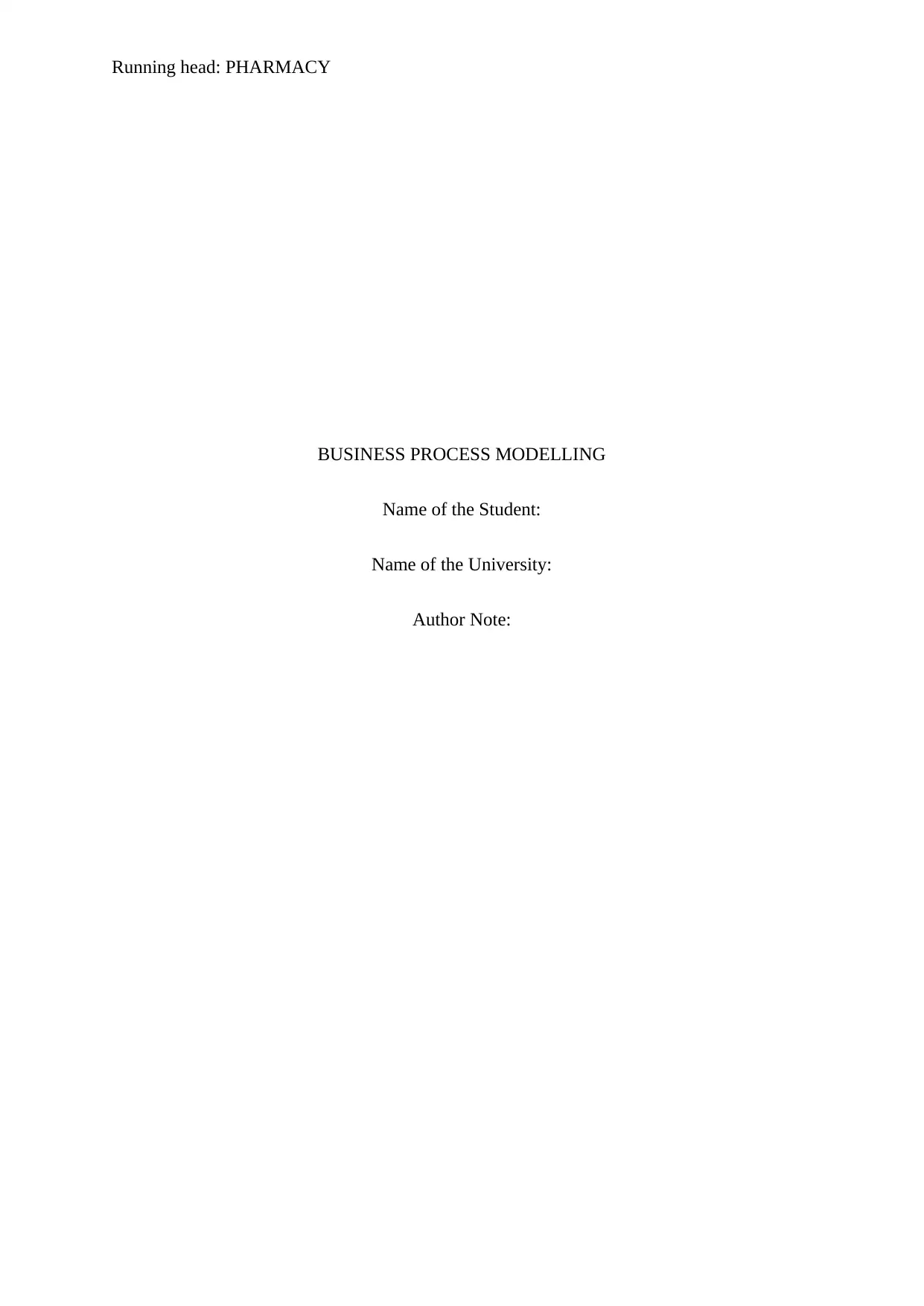
Running head: PHARMACY
BUSINESS PROCESS MODELLING
Name of the Student:
Name of the University:
Author Note:
BUSINESS PROCESS MODELLING
Name of the Student:
Name of the University:
Author Note:
Paraphrase This Document
Need a fresh take? Get an instant paraphrase of this document with our AI Paraphraser
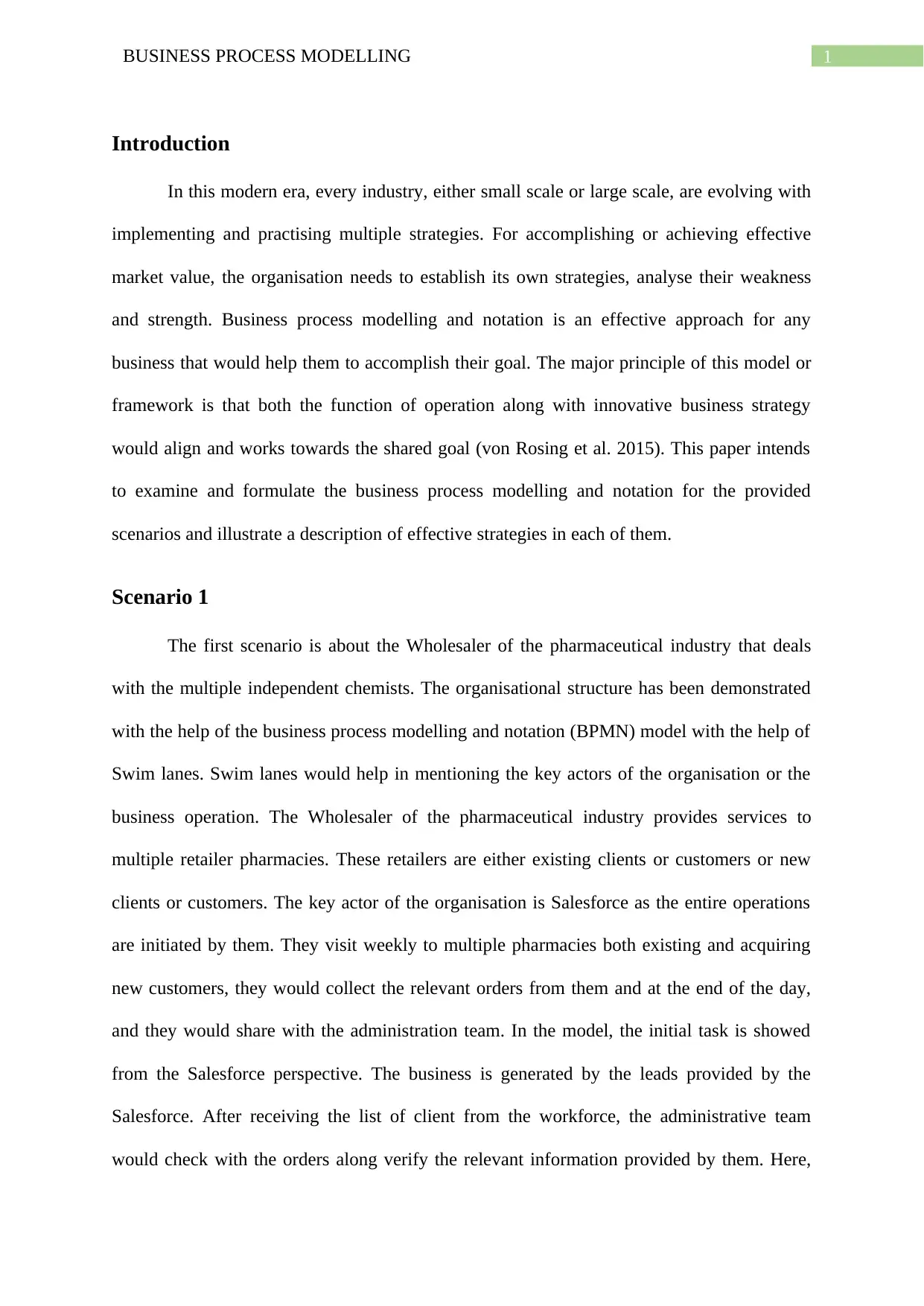
1BUSINESS PROCESS MODELLING
Introduction
In this modern era, every industry, either small scale or large scale, are evolving with
implementing and practising multiple strategies. For accomplishing or achieving effective
market value, the organisation needs to establish its own strategies, analyse their weakness
and strength. Business process modelling and notation is an effective approach for any
business that would help them to accomplish their goal. The major principle of this model or
framework is that both the function of operation along with innovative business strategy
would align and works towards the shared goal (von Rosing et al. 2015). This paper intends
to examine and formulate the business process modelling and notation for the provided
scenarios and illustrate a description of effective strategies in each of them.
Scenario 1
The first scenario is about the Wholesaler of the pharmaceutical industry that deals
with the multiple independent chemists. The organisational structure has been demonstrated
with the help of the business process modelling and notation (BPMN) model with the help of
Swim lanes. Swim lanes would help in mentioning the key actors of the organisation or the
business operation. The Wholesaler of the pharmaceutical industry provides services to
multiple retailer pharmacies. These retailers are either existing clients or customers or new
clients or customers. The key actor of the organisation is Salesforce as the entire operations
are initiated by them. They visit weekly to multiple pharmacies both existing and acquiring
new customers, they would collect the relevant orders from them and at the end of the day,
and they would share with the administration team. In the model, the initial task is showed
from the Salesforce perspective. The business is generated by the leads provided by the
Salesforce. After receiving the list of client from the workforce, the administrative team
would check with the orders along verify the relevant information provided by them. Here,
Introduction
In this modern era, every industry, either small scale or large scale, are evolving with
implementing and practising multiple strategies. For accomplishing or achieving effective
market value, the organisation needs to establish its own strategies, analyse their weakness
and strength. Business process modelling and notation is an effective approach for any
business that would help them to accomplish their goal. The major principle of this model or
framework is that both the function of operation along with innovative business strategy
would align and works towards the shared goal (von Rosing et al. 2015). This paper intends
to examine and formulate the business process modelling and notation for the provided
scenarios and illustrate a description of effective strategies in each of them.
Scenario 1
The first scenario is about the Wholesaler of the pharmaceutical industry that deals
with the multiple independent chemists. The organisational structure has been demonstrated
with the help of the business process modelling and notation (BPMN) model with the help of
Swim lanes. Swim lanes would help in mentioning the key actors of the organisation or the
business operation. The Wholesaler of the pharmaceutical industry provides services to
multiple retailer pharmacies. These retailers are either existing clients or customers or new
clients or customers. The key actor of the organisation is Salesforce as the entire operations
are initiated by them. They visit weekly to multiple pharmacies both existing and acquiring
new customers, they would collect the relevant orders from them and at the end of the day,
and they would share with the administration team. In the model, the initial task is showed
from the Salesforce perspective. The business is generated by the leads provided by the
Salesforce. After receiving the list of client from the workforce, the administrative team
would check with the orders along verify the relevant information provided by them. Here,
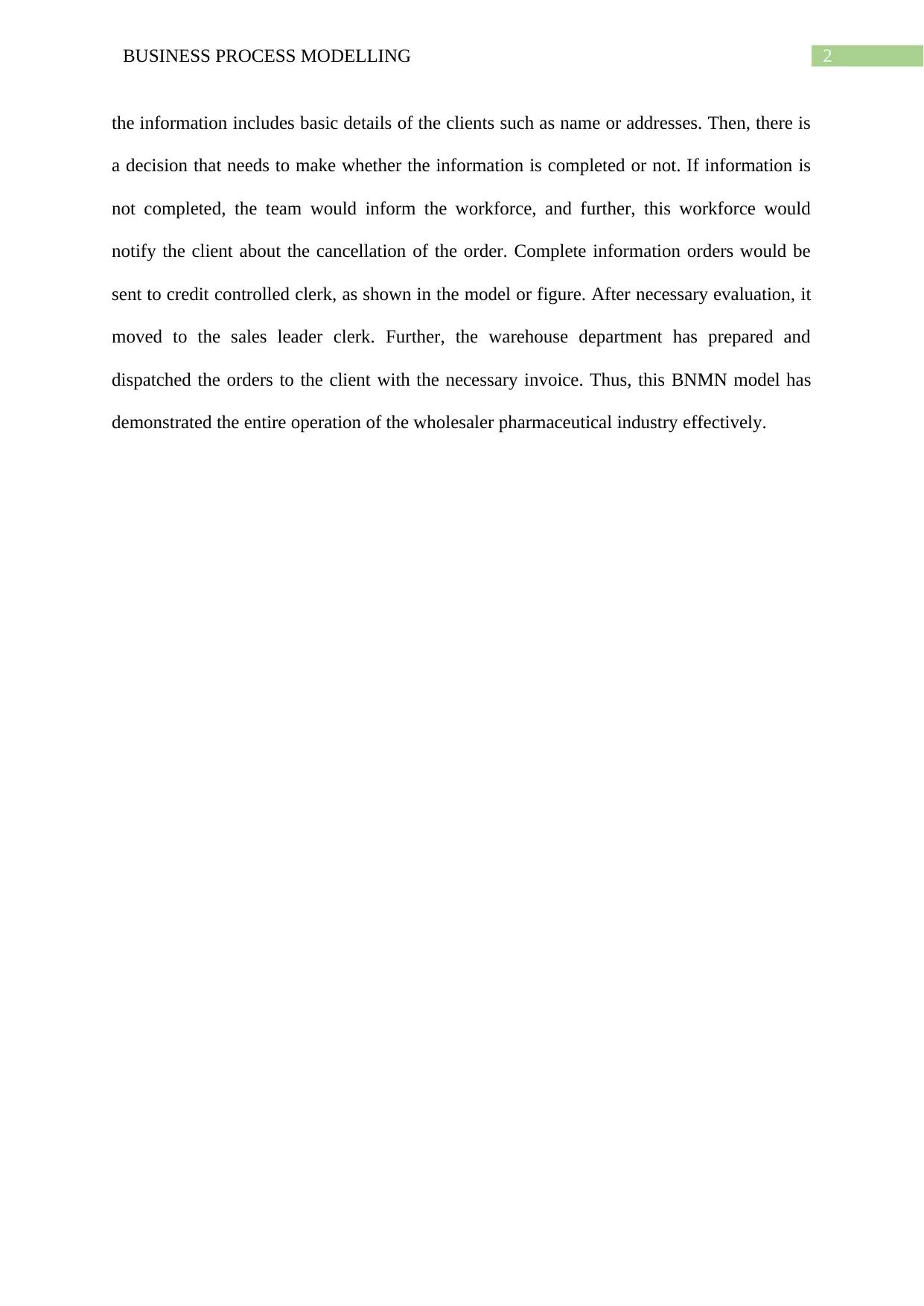
2BUSINESS PROCESS MODELLING
the information includes basic details of the clients such as name or addresses. Then, there is
a decision that needs to make whether the information is completed or not. If information is
not completed, the team would inform the workforce, and further, this workforce would
notify the client about the cancellation of the order. Complete information orders would be
sent to credit controlled clerk, as shown in the model or figure. After necessary evaluation, it
moved to the sales leader clerk. Further, the warehouse department has prepared and
dispatched the orders to the client with the necessary invoice. Thus, this BNMN model has
demonstrated the entire operation of the wholesaler pharmaceutical industry effectively.
the information includes basic details of the clients such as name or addresses. Then, there is
a decision that needs to make whether the information is completed or not. If information is
not completed, the team would inform the workforce, and further, this workforce would
notify the client about the cancellation of the order. Complete information orders would be
sent to credit controlled clerk, as shown in the model or figure. After necessary evaluation, it
moved to the sales leader clerk. Further, the warehouse department has prepared and
dispatched the orders to the client with the necessary invoice. Thus, this BNMN model has
demonstrated the entire operation of the wholesaler pharmaceutical industry effectively.
⊘ This is a preview!⊘
Do you want full access?
Subscribe today to unlock all pages.

Trusted by 1+ million students worldwide
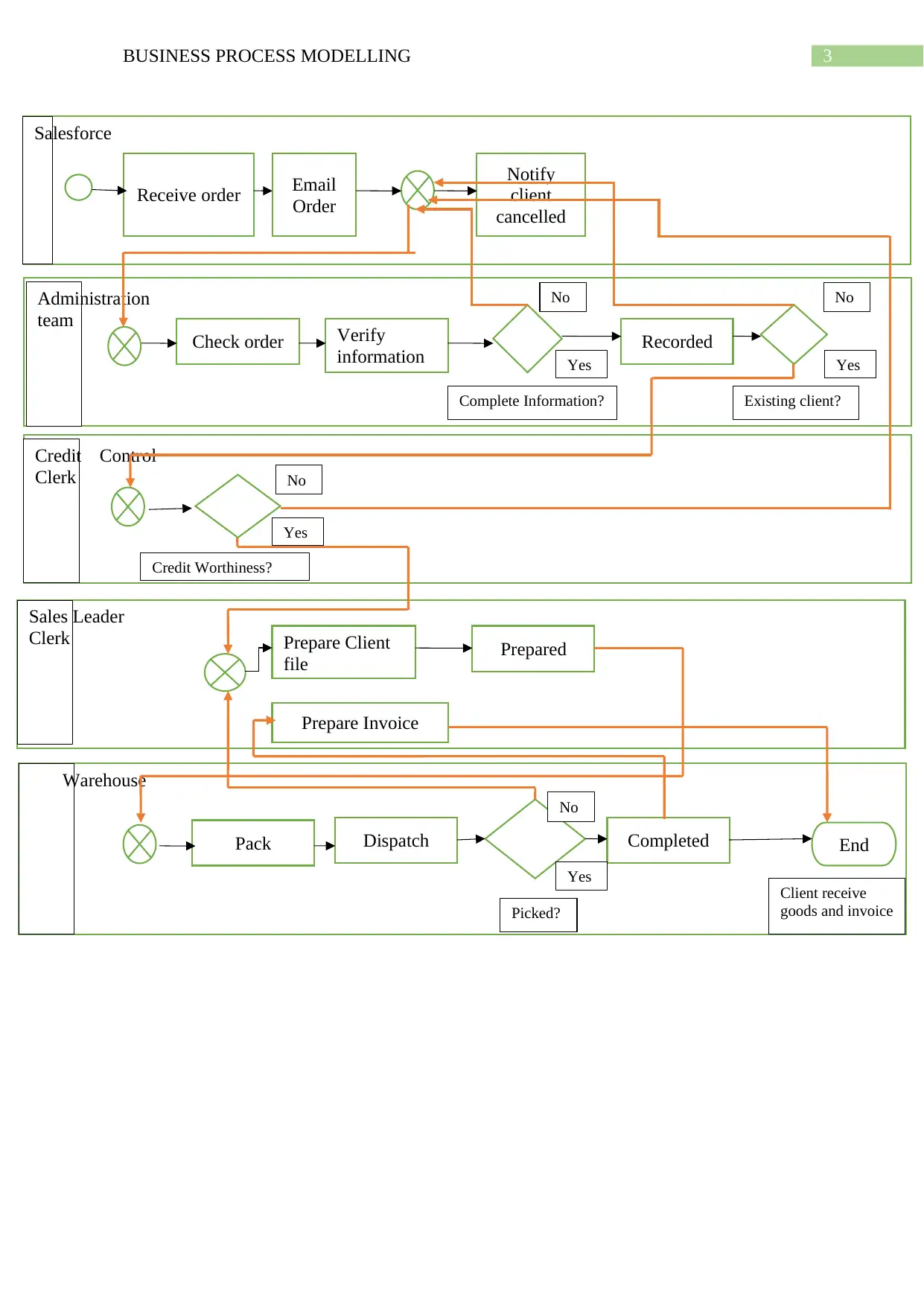
3BUSINESS PROCESS MODELLING
Salesforce
Receive order Email
Order
Notify
client
cancelled
Administration
team
Check order Verify
information Recorded
Prepare Client
file Prepared
Prepare Invoice
Pack Dispatch Completed
Credit Control
Clerk
Sales Leader
Clerk
Warehouse
Complete Information? Existing client?
Credit Worthiness?
Picked?
End
Client receive
goods and invoice
No
Yes
Yes
Yes Yes
No
No No
Salesforce
Receive order Email
Order
Notify
client
cancelled
Administration
team
Check order Verify
information Recorded
Prepare Client
file Prepared
Prepare Invoice
Pack Dispatch Completed
Credit Control
Clerk
Sales Leader
Clerk
Warehouse
Complete Information? Existing client?
Credit Worthiness?
Picked?
End
Client receive
goods and invoice
No
Yes
Yes
Yes Yes
No
No No
Paraphrase This Document
Need a fresh take? Get an instant paraphrase of this document with our AI Paraphraser
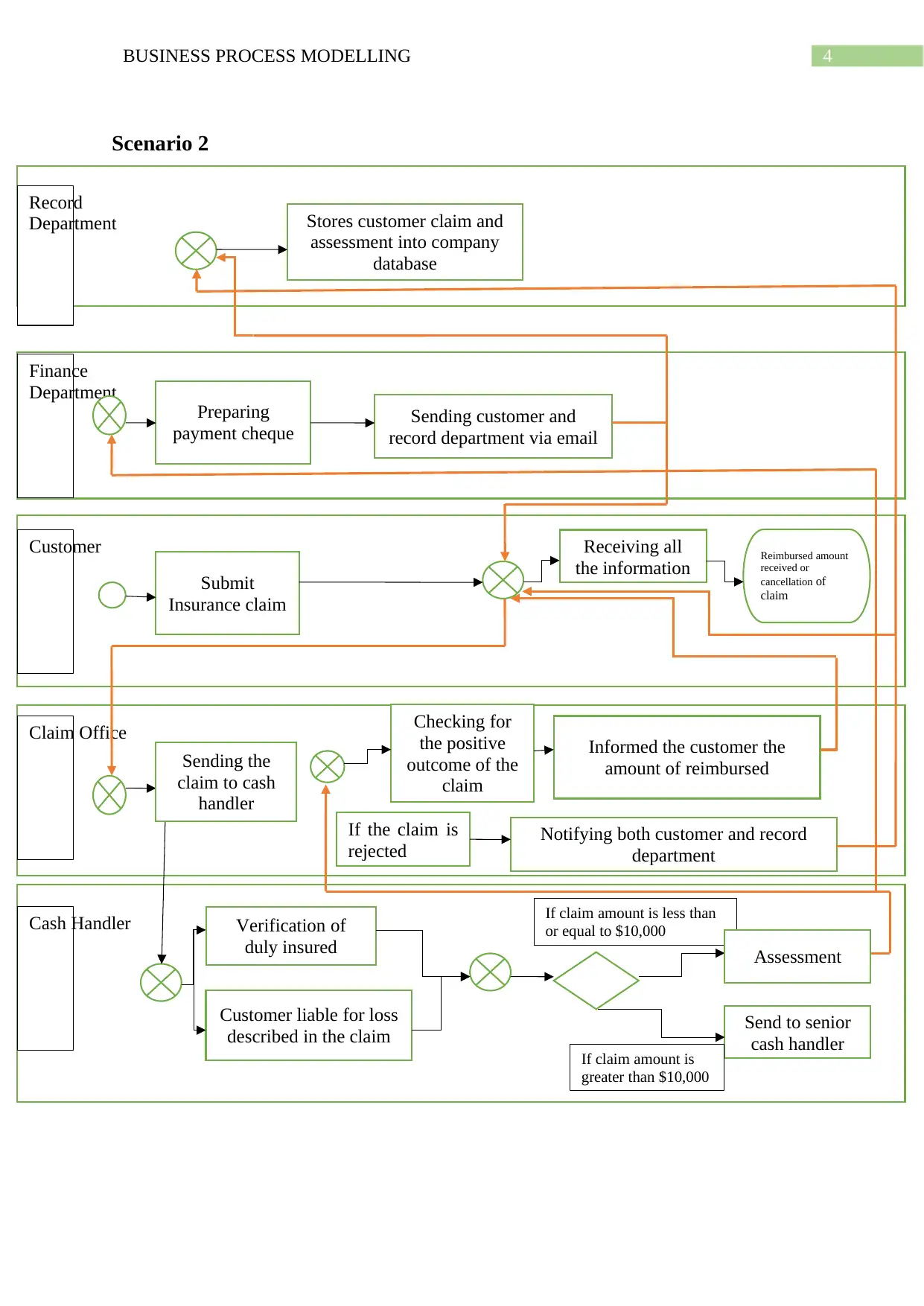
4BUSINESS PROCESS MODELLING
Scenario 2
Record
Department
Finance
Department
Customer
Claim Office
Cash Handler
Stores customer claim and
assessment into company
database
Preparing
payment cheque Sending customer and
record department via email
Submit
Insurance claim
Checking for
the positive
outcome of the
claim
Informed the customer the
amount of reimbursed
Verification of
duly insured
Customer liable for loss
described in the claim
If the claim is
rejected Notifying both customer and record
department
Send to senior
cash handler
Reimbursed amount
received or
cancellation of
claim
Receiving all
the information
Sending the
claim to cash
handler
If claim amount is
greater than $10,000
If claim amount is less than
or equal to $10,000
Assessment
Scenario 2
Record
Department
Finance
Department
Customer
Claim Office
Cash Handler
Stores customer claim and
assessment into company
database
Preparing
payment cheque Sending customer and
record department via email
Submit
Insurance claim
Checking for
the positive
outcome of the
claim
Informed the customer the
amount of reimbursed
Verification of
duly insured
Customer liable for loss
described in the claim
If the claim is
rejected Notifying both customer and record
department
Send to senior
cash handler
Reimbursed amount
received or
cancellation of
claim
Receiving all
the information
Sending the
claim to cash
handler
If claim amount is
greater than $10,000
If claim amount is less than
or equal to $10,000
Assessment
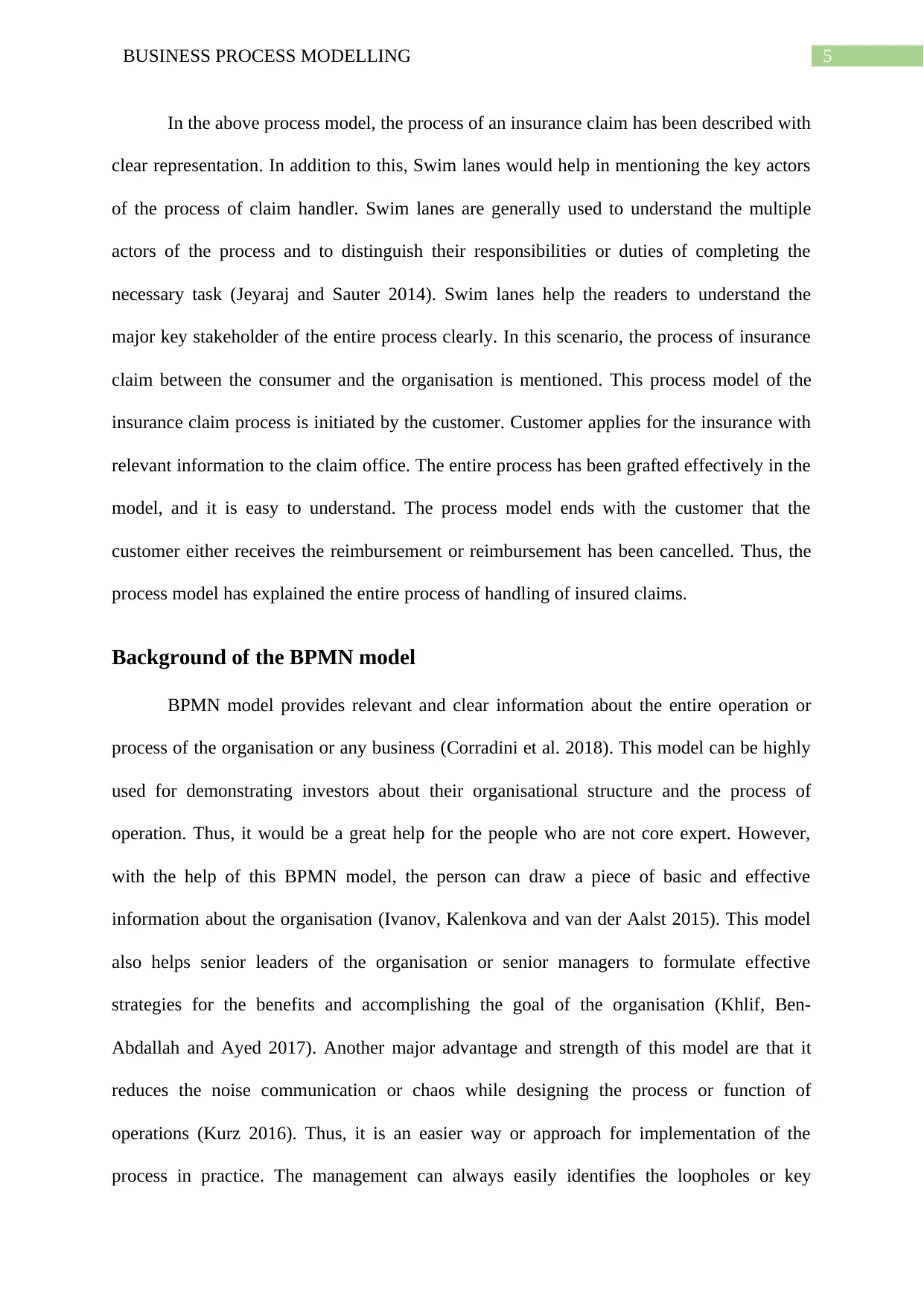
5BUSINESS PROCESS MODELLING
In the above process model, the process of an insurance claim has been described with
clear representation. In addition to this, Swim lanes would help in mentioning the key actors
of the process of claim handler. Swim lanes are generally used to understand the multiple
actors of the process and to distinguish their responsibilities or duties of completing the
necessary task (Jeyaraj and Sauter 2014). Swim lanes help the readers to understand the
major key stakeholder of the entire process clearly. In this scenario, the process of insurance
claim between the consumer and the organisation is mentioned. This process model of the
insurance claim process is initiated by the customer. Customer applies for the insurance with
relevant information to the claim office. The entire process has been grafted effectively in the
model, and it is easy to understand. The process model ends with the customer that the
customer either receives the reimbursement or reimbursement has been cancelled. Thus, the
process model has explained the entire process of handling of insured claims.
Background of the BPMN model
BPMN model provides relevant and clear information about the entire operation or
process of the organisation or any business (Corradini et al. 2018). This model can be highly
used for demonstrating investors about their organisational structure and the process of
operation. Thus, it would be a great help for the people who are not core expert. However,
with the help of this BPMN model, the person can draw a piece of basic and effective
information about the organisation (Ivanov, Kalenkova and van der Aalst 2015). This model
also helps senior leaders of the organisation or senior managers to formulate effective
strategies for the benefits and accomplishing the goal of the organisation (Khlif, Ben-
Abdallah and Ayed 2017). Another major advantage and strength of this model are that it
reduces the noise communication or chaos while designing the process or function of
operations (Kurz 2016). Thus, it is an easier way or approach for implementation of the
process in practice. The management can always easily identifies the loopholes or key
In the above process model, the process of an insurance claim has been described with
clear representation. In addition to this, Swim lanes would help in mentioning the key actors
of the process of claim handler. Swim lanes are generally used to understand the multiple
actors of the process and to distinguish their responsibilities or duties of completing the
necessary task (Jeyaraj and Sauter 2014). Swim lanes help the readers to understand the
major key stakeholder of the entire process clearly. In this scenario, the process of insurance
claim between the consumer and the organisation is mentioned. This process model of the
insurance claim process is initiated by the customer. Customer applies for the insurance with
relevant information to the claim office. The entire process has been grafted effectively in the
model, and it is easy to understand. The process model ends with the customer that the
customer either receives the reimbursement or reimbursement has been cancelled. Thus, the
process model has explained the entire process of handling of insured claims.
Background of the BPMN model
BPMN model provides relevant and clear information about the entire operation or
process of the organisation or any business (Corradini et al. 2018). This model can be highly
used for demonstrating investors about their organisational structure and the process of
operation. Thus, it would be a great help for the people who are not core expert. However,
with the help of this BPMN model, the person can draw a piece of basic and effective
information about the organisation (Ivanov, Kalenkova and van der Aalst 2015). This model
also helps senior leaders of the organisation or senior managers to formulate effective
strategies for the benefits and accomplishing the goal of the organisation (Khlif, Ben-
Abdallah and Ayed 2017). Another major advantage and strength of this model are that it
reduces the noise communication or chaos while designing the process or function of
operations (Kurz 2016). Thus, it is an easier way or approach for implementation of the
process in practice. The management can always easily identifies the loopholes or key
⊘ This is a preview!⊘
Do you want full access?
Subscribe today to unlock all pages.

Trusted by 1+ million students worldwide
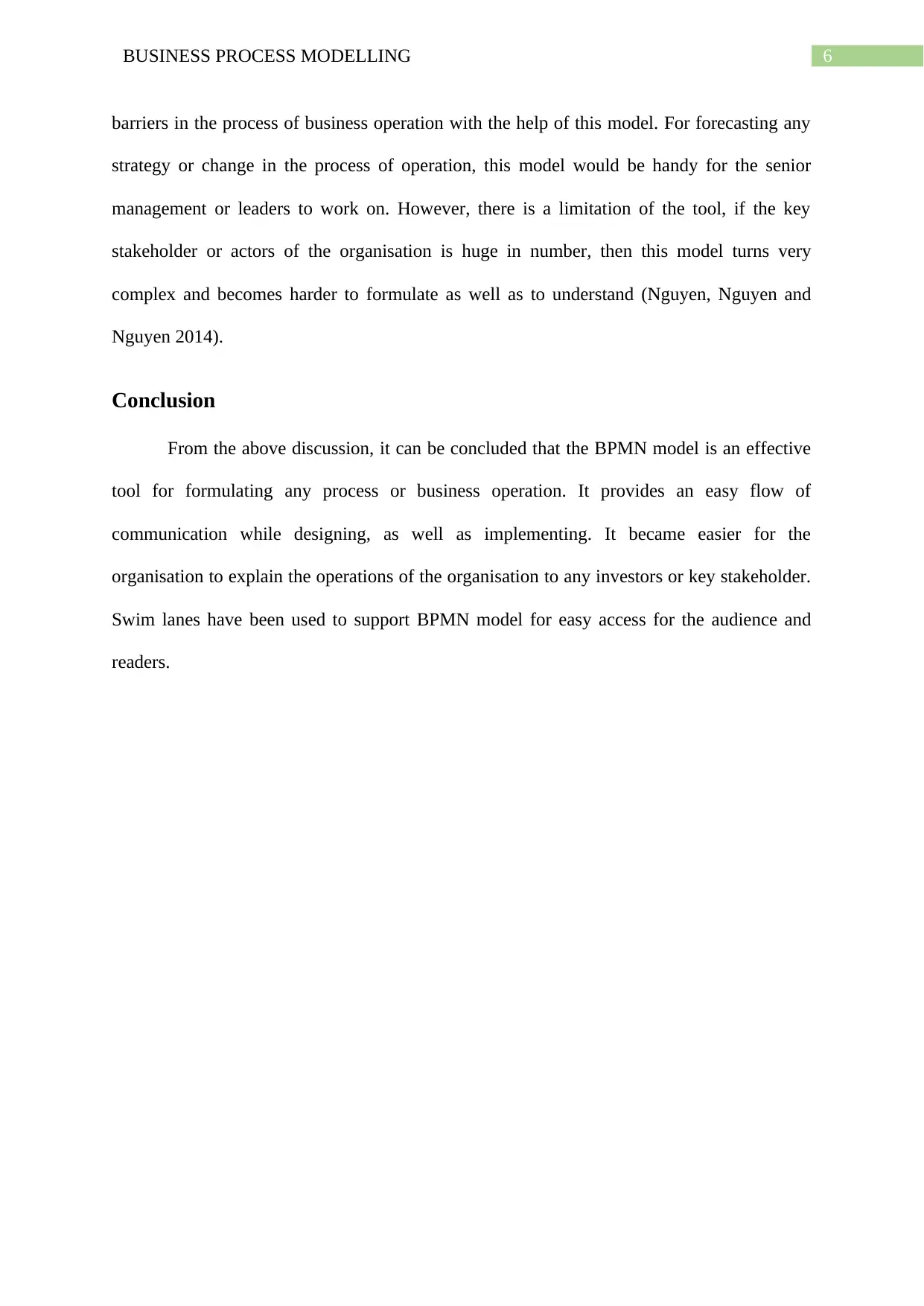
6BUSINESS PROCESS MODELLING
barriers in the process of business operation with the help of this model. For forecasting any
strategy or change in the process of operation, this model would be handy for the senior
management or leaders to work on. However, there is a limitation of the tool, if the key
stakeholder or actors of the organisation is huge in number, then this model turns very
complex and becomes harder to formulate as well as to understand (Nguyen, Nguyen and
Nguyen 2014).
Conclusion
From the above discussion, it can be concluded that the BPMN model is an effective
tool for formulating any process or business operation. It provides an easy flow of
communication while designing, as well as implementing. It became easier for the
organisation to explain the operations of the organisation to any investors or key stakeholder.
Swim lanes have been used to support BPMN model for easy access for the audience and
readers.
barriers in the process of business operation with the help of this model. For forecasting any
strategy or change in the process of operation, this model would be handy for the senior
management or leaders to work on. However, there is a limitation of the tool, if the key
stakeholder or actors of the organisation is huge in number, then this model turns very
complex and becomes harder to formulate as well as to understand (Nguyen, Nguyen and
Nguyen 2014).
Conclusion
From the above discussion, it can be concluded that the BPMN model is an effective
tool for formulating any process or business operation. It provides an easy flow of
communication while designing, as well as implementing. It became easier for the
organisation to explain the operations of the organisation to any investors or key stakeholder.
Swim lanes have been used to support BPMN model for easy access for the audience and
readers.
Paraphrase This Document
Need a fresh take? Get an instant paraphrase of this document with our AI Paraphraser
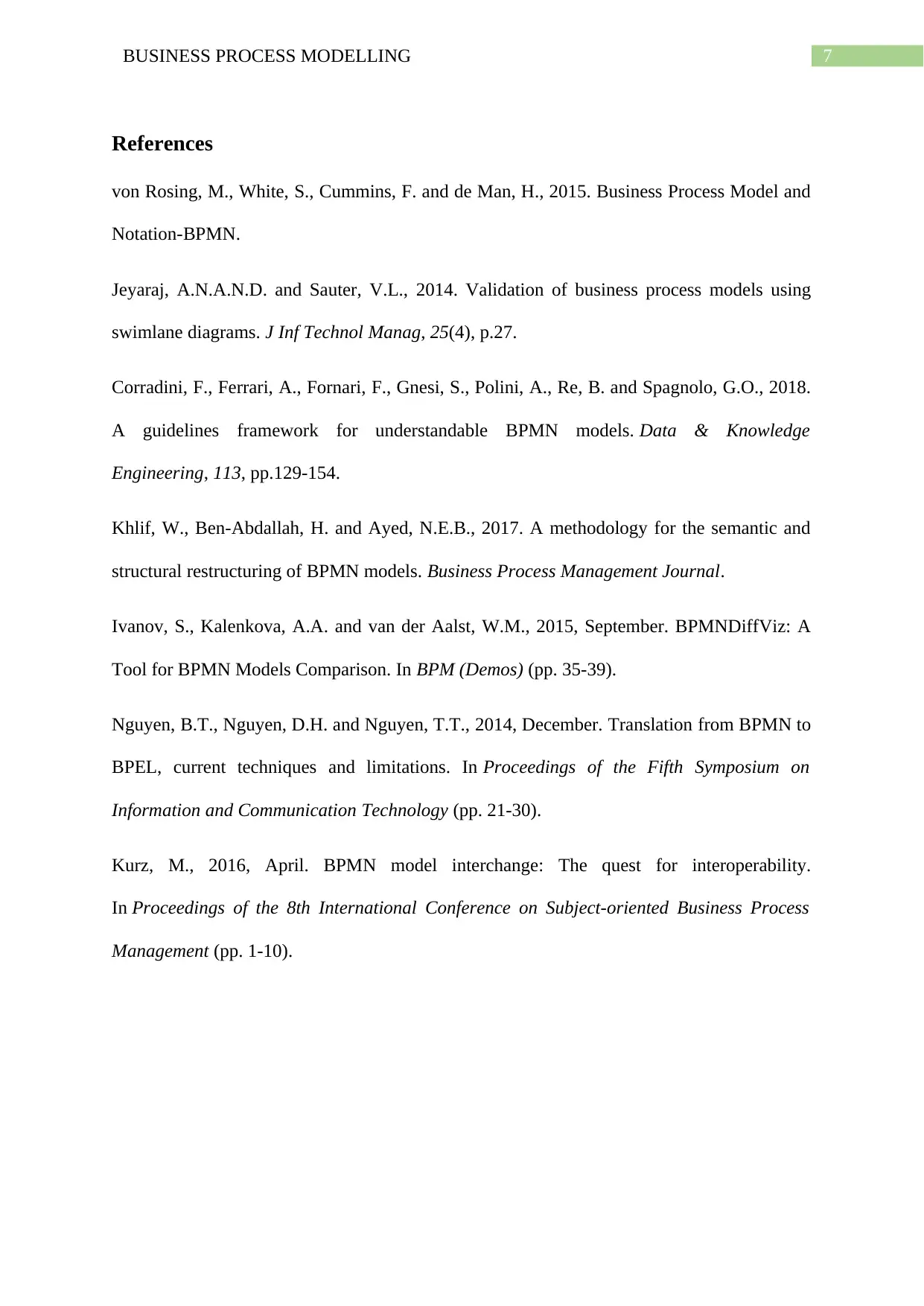
7BUSINESS PROCESS MODELLING
References
von Rosing, M., White, S., Cummins, F. and de Man, H., 2015. Business Process Model and
Notation-BPMN.
Jeyaraj, A.N.A.N.D. and Sauter, V.L., 2014. Validation of business process models using
swimlane diagrams. J Inf Technol Manag, 25(4), p.27.
Corradini, F., Ferrari, A., Fornari, F., Gnesi, S., Polini, A., Re, B. and Spagnolo, G.O., 2018.
A guidelines framework for understandable BPMN models. Data & Knowledge
Engineering, 113, pp.129-154.
Khlif, W., Ben-Abdallah, H. and Ayed, N.E.B., 2017. A methodology for the semantic and
structural restructuring of BPMN models. Business Process Management Journal.
Ivanov, S., Kalenkova, A.A. and van der Aalst, W.M., 2015, September. BPMNDiffViz: A
Tool for BPMN Models Comparison. In BPM (Demos) (pp. 35-39).
Nguyen, B.T., Nguyen, D.H. and Nguyen, T.T., 2014, December. Translation from BPMN to
BPEL, current techniques and limitations. In Proceedings of the Fifth Symposium on
Information and Communication Technology (pp. 21-30).
Kurz, M., 2016, April. BPMN model interchange: The quest for interoperability.
In Proceedings of the 8th International Conference on Subject-oriented Business Process
Management (pp. 1-10).
References
von Rosing, M., White, S., Cummins, F. and de Man, H., 2015. Business Process Model and
Notation-BPMN.
Jeyaraj, A.N.A.N.D. and Sauter, V.L., 2014. Validation of business process models using
swimlane diagrams. J Inf Technol Manag, 25(4), p.27.
Corradini, F., Ferrari, A., Fornari, F., Gnesi, S., Polini, A., Re, B. and Spagnolo, G.O., 2018.
A guidelines framework for understandable BPMN models. Data & Knowledge
Engineering, 113, pp.129-154.
Khlif, W., Ben-Abdallah, H. and Ayed, N.E.B., 2017. A methodology for the semantic and
structural restructuring of BPMN models. Business Process Management Journal.
Ivanov, S., Kalenkova, A.A. and van der Aalst, W.M., 2015, September. BPMNDiffViz: A
Tool for BPMN Models Comparison. In BPM (Demos) (pp. 35-39).
Nguyen, B.T., Nguyen, D.H. and Nguyen, T.T., 2014, December. Translation from BPMN to
BPEL, current techniques and limitations. In Proceedings of the Fifth Symposium on
Information and Communication Technology (pp. 21-30).
Kurz, M., 2016, April. BPMN model interchange: The quest for interoperability.
In Proceedings of the 8th International Conference on Subject-oriented Business Process
Management (pp. 1-10).
1 out of 8
Your All-in-One AI-Powered Toolkit for Academic Success.
+13062052269
info@desklib.com
Available 24*7 on WhatsApp / Email
![[object Object]](/_next/static/media/star-bottom.7253800d.svg)
Unlock your academic potential
Copyright © 2020–2025 A2Z Services. All Rights Reserved. Developed and managed by ZUCOL.